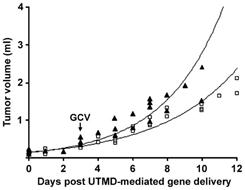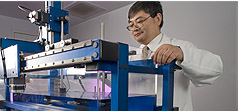New Clinical Therapeutic Applications
Microbubble-Mediated Gene Delivery Via Ultrasound Induced Microbubble Destruction
Advancement of gene therapy has been hampered, in part, by limitations in the delivery vectors for therapeutic genes. Viral vectors are effective in facilitating gene transfer, but are immunogenic, can transfect non-target organs, and raise concerns regarding potential for causing clinical disease. Non-viral vectors are limited by transduction efficiency and poor ability to transgress the vascular wall. It has been shown by others that attachment of genes to microbubbles followed by disruption of the bubbles by ultrasound (i.e. rupture), enhances gene transfer and/or gene expression by cells outside of the vasculature. The mechanism for this is unknown, and the optimal delivery parameters, including microbubble formulations and ultrasound settings, have yet to be elucidated. We are currently studying applications of this non-viral gene delivery approach in the treatment of vascular disease and malignant tumors, in collaboration with Dr. McTiernan. This approach may permit simultaneous imaging and delivery of therapeutics.
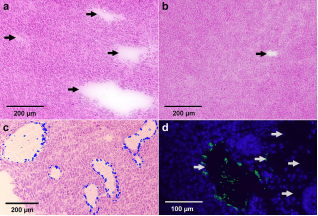
Ultrasound in conjunction with microbubbles can deliver genes and drugs for therapeutic purposes. Postmortem histology of tumors in mice after intravenous delivery of either pCMV-TK (a, c, d) or pEGFP-C1 (b)-loaded microbubbles and treatment with ultrasound and ganciclovir. (a, b) Acellular zones (arrows) visible under H&E stain. (c) Merged image of two sister slides, one stained by Heoscht 33342 (blue overlay) and one stained by H&E. (d) Variable vWF staining in acellular zones (arrows). Adapted from Carson AE,…, Villanueva FS. Gene therapy of carcinoma using ultrasound-targeted microbubble destruction. Ultrasound Med Biol 2011;37.
Growth of murine tumors after intravenous injection of either pCMV-TK (□) or pEGFP-C1 (▲)-loaded microbubbles and treated with ultrasound. Daily GCV injections began on day 3.. Adapted from Carson AE, …, Villanueva FS. Gene therapy of carcinoma using ultrasound-targeted microbubble destruction. Ultrasound Med Biol 2011;37.

3D tumor volumes in mice receiving UTMD-mediated delivery of control siRNA (top) or UTMD-mediated delivery of EGFR–siRNA (bottom) on days 1 and 5. Adapted from Carson AR, …, Villanueva FS. Ultrasound-targeted microbubble destruction to deliver siRNA. Cancer Research 2012;72.
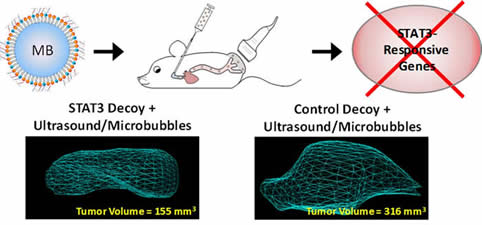
Signal transducer and activator of transcription 3 (STAT3) is constitutively activated in many cancers where it acts to promote tumor progression. A STAT3-specific transcription factor decoy has been developed to suppress STAT3 downstream signaling, but a delivery strategy is needed to improve clinical translation. In this study, we have successfully used ultrasound and microbubbles loaded with STAT3 decoy to deliver STAT3 decoy locally to tumor to disrupt STAT3 signaling and inhibit tumor growth. Adapted from Kopechek J, …, Villanueva FS, Ultrasound targeted microbubble destruction-mediated delivery of a transcription factor decoy inhibits STAT3 signaling and tumor growth. Theranostics 2015;5.
Ultrasound-Microbubble-Mediated Drug Delivery
Doxorubicin (Dox) is a chemotherapeutic agent used in the treatment of various types of cancer, but its dosage and efficacy are limited by cardiotoxicity and myelosuppression. Encapsulating doxorubicin in liposomes (e.g. Doxil) has been successful at accumulating drug in the tumors and away from the heart, but has failed at improving patient outcome, possibly due to insufficient drug release from the liposomes. Ultrasound targeted microbubble oscillations have been shown to improve the cytotoxicity of liposomal doxorubicin. However, the ultrasound pulses that maximize drug release, drug uptake and therapeutic cytotoxicity remain to be elucidated. We are developing a delivery vehicle that maintained drug encapsulated at 37°C and released drug after triggering by ultrasound. This approach has the potential for local delivery of anthracyclines to tumoral tissues with reduced systemic toxicity.
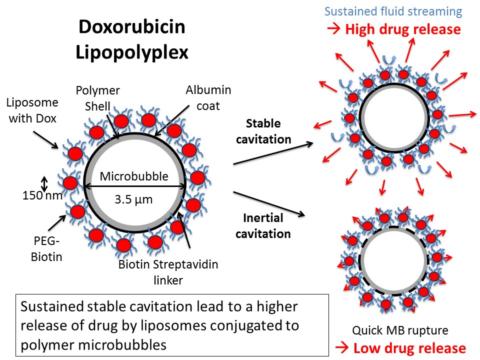
Cardiotoxicity is the major dose-limiting factor in the chemotherapeutic use of doxorubicin (Dox). A delivery vehicle that can be triggered to release its payload in the tumoral microvasculature but not in healthy tissue would help improve the therapeutic window of the drug. Delivery strategies combining liposomal encapsulated Dox (LDox), microbubbles (MB) and ultrasound (US) have been shown to improve therapeutic efficacy of LDox. Much remains to be known about the mechanisms and the US conditions that maximize cytotoxicity using this approach. Adapted from Yu FTH, …, Villanueva FS. Low intensity ultrasound mediated liposomal doxorubicin release, cellular uptake kinetics and growth inhibition using polymer microbubbles. Mol Pharmaceutics 2016;13.
Therapeutic Application Of Acoustic Radiation Force To Facilitate Endothelial Cell Trafficking
Acoustic radiation force is a physical phenomenon whereby microbubbles move away from the source of ultrasound when it is delivered at sufficient power and appropriate frequency. We are testing the hypothesis that this microbubble behavior can be harnessed for therapeutic purposes as a means to accelerate re-endothelialization of injured vessels. This project is being spearheaded by Catalin Toma, MD in collaboration with Xucai Chen, PhD.
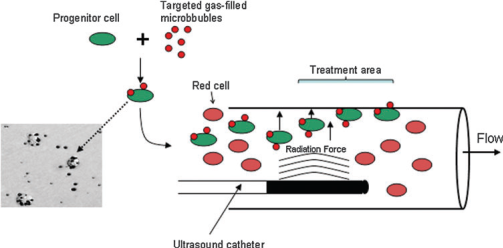
Ultrasound radiation force-mediated delivery of stem cells to vascular targets. Adapted from Toma C,…, Villanueva FS. Vascular endoluminal delivery of stem cells using acoustic radiation force. Tissue Eng Part A 2011:17.

The MSCs adherent to the aortic endoluminal surface after ultrasound mediated delivery survive and undergo morphological changes, between immediate (two examples in A) 3h (B), and 24 h (C) post delivery with ultrasound radiation force.. Adapted from Toma C,…, Villanueva FS. Vascular endoluminal delivery of stem cells using acoustic radiation force. Tissue Eng Part A 2011:17.

Quantification of microbubble attachment of mesenchymal stem cells (MSCs) using flow cytometry. Adapted from Kaya M,…, Villanueva FS, Chen X. Acoustic radiation force for vascular cell therapy: In vitro validation. Ultrasound Med Biol, 2012;38.

Acoustic radiation force on microbubbles can be used to delivery stem cells for vascular cell therapy. Shown are flow trajectories of microbubble-cell complexes for various acoustic pressures and duty cycles after maximum intensity persistence processing. Adapted from Kaya M,…, Villanueva FS, Chen X. Acoustic radiation force for vascular cell therapy: In vitro validation. Ultrasound Med Biol, 2012;38.
Ultrasound-Microbubble-Mediated Microvascular Reperfusion
Embolization of thrombotic plaque components to the distal microvasculature during PCI is a prevalent phenomenon that leads to suboptimal microvascular perfusion despite apparent patency of the epicardial coronary artery. This phenomenon is associated with higher morbidity, and treatment strategies are currently suboptimal. In our center, we have been developing in vitro and in vivo models of microvascular obstruction and using ultrasound activated microbubbles to enhance microvascular reperfusion (sonoreperfusion), as an adjunctive therapy immediately after PCI of the upstream epicardial coronary artery. This project is being spearheaded by John Pacella, MD.
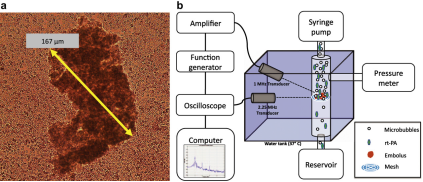
In vitro model of microvascular embolization and sonoreperfusion. Adapted from Leeman JE, …, Villanueva FS, Pacella JJ. Effect of acoustic conditions on microbubble-mediated microvascular sonothrombolysis. Ultrasound Med Biol 2012;38.
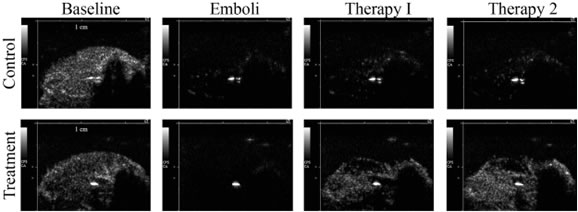
In vivo model of sonoreperfusion. Contrast ultrasound images from control (top) and treatment (bottom) animals at each of four experimental stages. Adapted from Pacella JJ, …,Villanueva FS. Treatment of microvascular micro-embolization using microbubbles and long-tone-burst ultrasound: an in vivo study. Ultrasound Med Biol 2015;41.
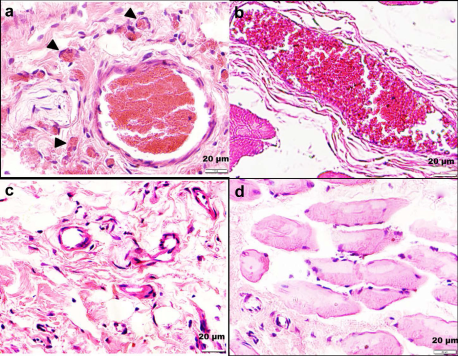
Hematoxylin and eosin-stained treated (c,d) and control (a,b) rat hindlimb muscle. The rats that received treatment had less microvascular obstruction than controls. Adapted from Pacella JJ, …,Villanueva FS. Treatment of microvascular micro-embolization using microbubbles and long-tone-burst ultrasound: an in vivo study. Ultrasound Med Biol 2015;41.
